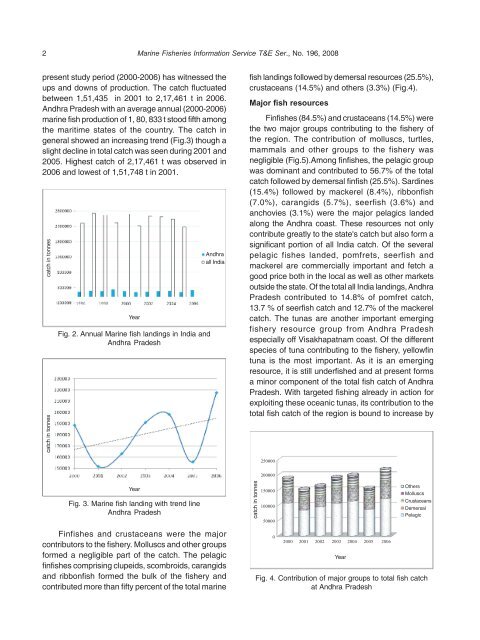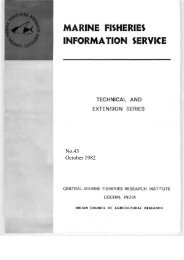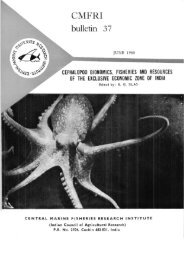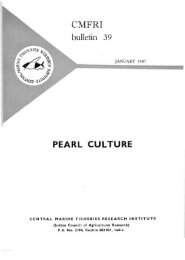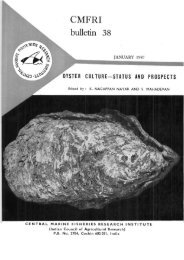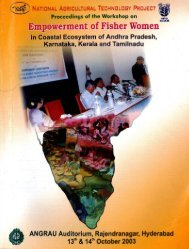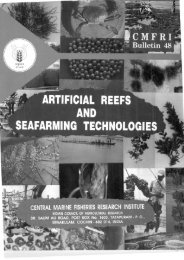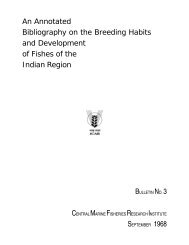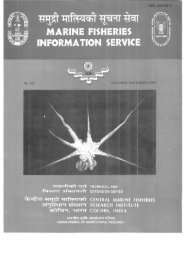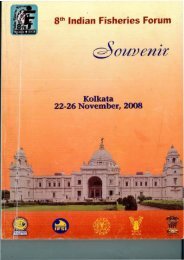Marine Fisheries Information Service - Eprints@CMFRI - Central ...
Marine Fisheries Information Service - Eprints@CMFRI - Central ...
Marine Fisheries Information Service - Eprints@CMFRI - Central ...
You also want an ePaper? Increase the reach of your titles
YUMPU automatically turns print PDFs into web optimized ePapers that Google loves.
2 <strong>Marine</strong> <strong>Fisheries</strong> <strong>Information</strong> <strong>Service</strong> T&E Ser., No. 196, 2008<br />
present study period (2000-2006) has witnessed the<br />
ups and downs of production. The catch fluctuated<br />
between 1,51,435 in 2001 to 2,17,461 t in 2006.<br />
Andhra Pradesh with an average annual (2000-2006)<br />
marine fish production of 1, 80, 833 t stood fifth among<br />
the maritime states of the country. The catch in<br />
general showed an increasing trend (Fig.3) though a<br />
slight decline in total catch was seen during 2001 and<br />
2005. Highest catch of 2,17,461 t was observed in<br />
2006 and lowest of 1,51,748 t in 2001.<br />
catch in tonnes<br />
catch in tonnes<br />
Year<br />
Fig. 2. Annual <strong>Marine</strong> fish landings in India and<br />
Andhra Pradesh<br />
Andhra<br />
all India<br />
fish landings followed by demersal resources (25.5%),<br />
crustaceans (14.5%) and others (3.3%) (Fig.4).<br />
Major fish resources<br />
Finfishes (84.5%) and crustaceans (14.5%) were<br />
the two major groups contributing to the fishery of<br />
the region. The contribution of molluscs, turtles,<br />
mammals and other groups to the fishery was<br />
negligible (Fig.5).Among finfishes, the pelagic group<br />
was dominant and contributed to 56.7% of the total<br />
catch followed by demersal finfish (25.5%). Sardines<br />
(15.4%) followed by mackerel (8.4%), ribbonfish<br />
(7.0%), carangids (5.7%), seerfish (3.6%) and<br />
anchovies (3.1%) were the major pelagics landed<br />
along the Andhra coast. These resources not only<br />
contribute greatly to the state's catch but also form a<br />
significant portion of all India catch. Of the several<br />
pelagic fishes landed, pomfrets, seerfish and<br />
mackerel are commercially important and fetch a<br />
good price both in the local as well as other markets<br />
outside the state. Of the total all India landings, Andhra<br />
Pradesh contributed to 14.8% of pomfret catch,<br />
13.7 % of seerfish catch and 12.7% of the mackerel<br />
catch. The tunas are another important emerging<br />
fishery resource group from Andhra Pradesh<br />
especially off Visakhapatnam coast. Of the different<br />
species of tuna contributing to the fishery, yellowfin<br />
tuna is the most important. As it is an emerging<br />
resource, it is still underfished and at present forms<br />
a minor component of the total fish catch of Andhra<br />
Pradesh. With targeted fishing already in action for<br />
exploiting these oceanic tunas, its contribution to the<br />
total fish catch of the region is bound to increase by<br />
250000<br />
200000<br />
Year<br />
Fig. 3. <strong>Marine</strong> fish landing with trend line<br />
Andhra Pradesh<br />
catch in tonnes<br />
150000<br />
100000<br />
50000<br />
Others<br />
Molluscs<br />
Crustaceans<br />
Demersal<br />
Pelagic<br />
Finfishes and crustaceans were the major<br />
contributors to the fishery. Molluscs and other groups<br />
formed a negligible part of the catch. The pelagic<br />
finfishes comprising clupeids, scombroids, carangids<br />
and ribbonfish formed the bulk of the fishery and<br />
contributed more than fifty percent of the total marine<br />
0<br />
2000 2001 2002 2003 2004 2005 2006<br />
Year<br />
Fig. 4. Contribution of major groups to total fish catch<br />
at Andhra Pradesh


